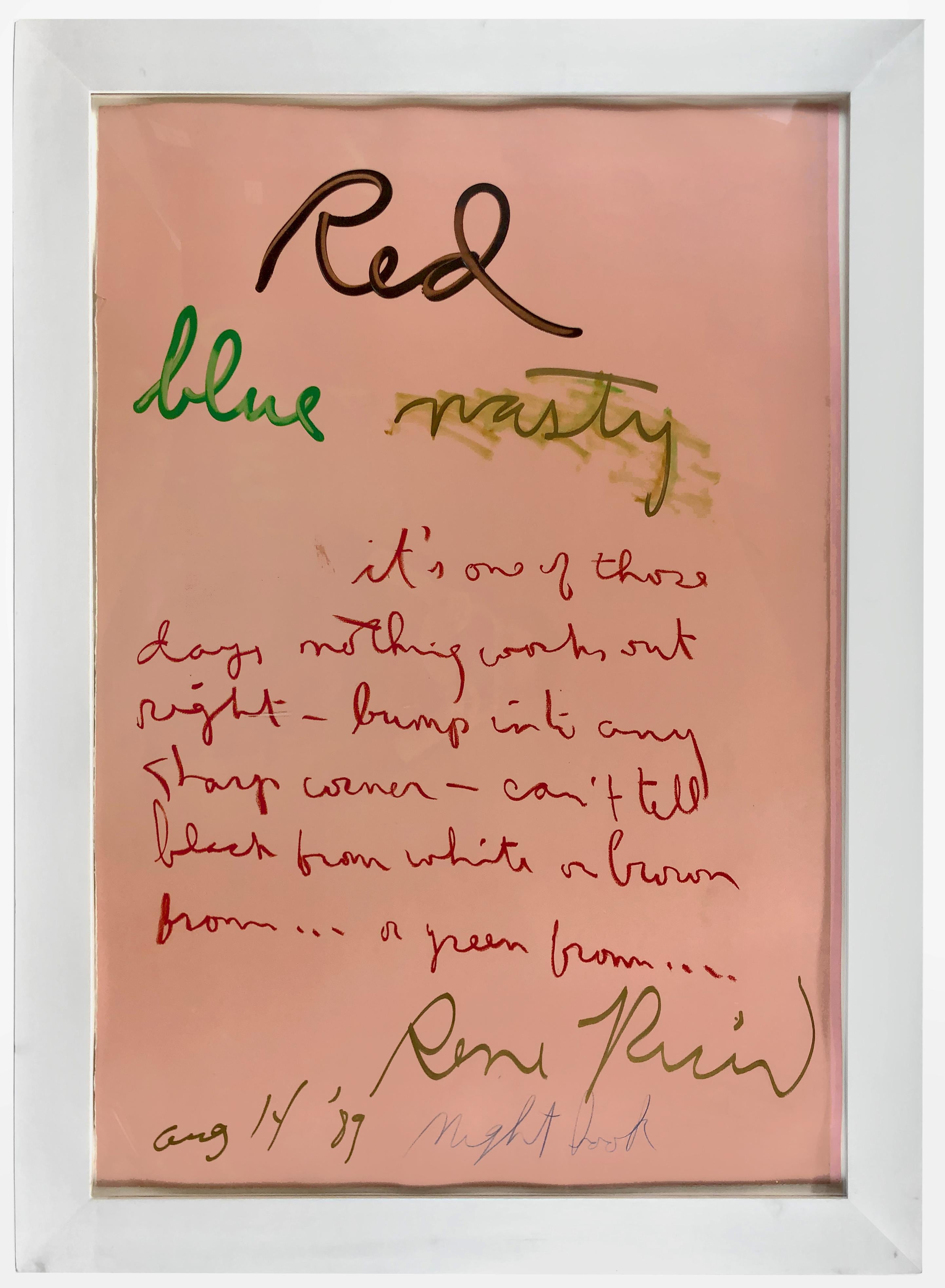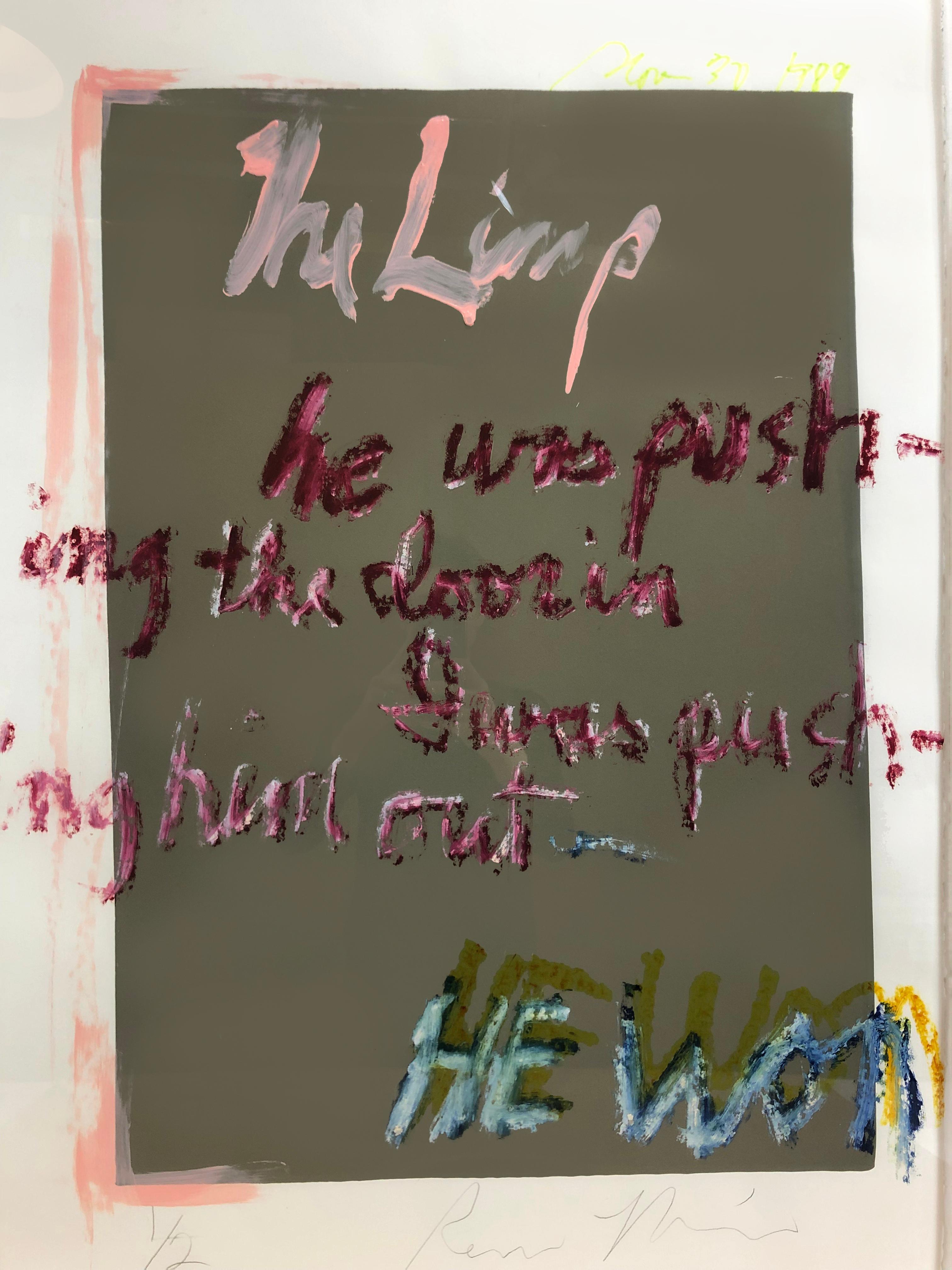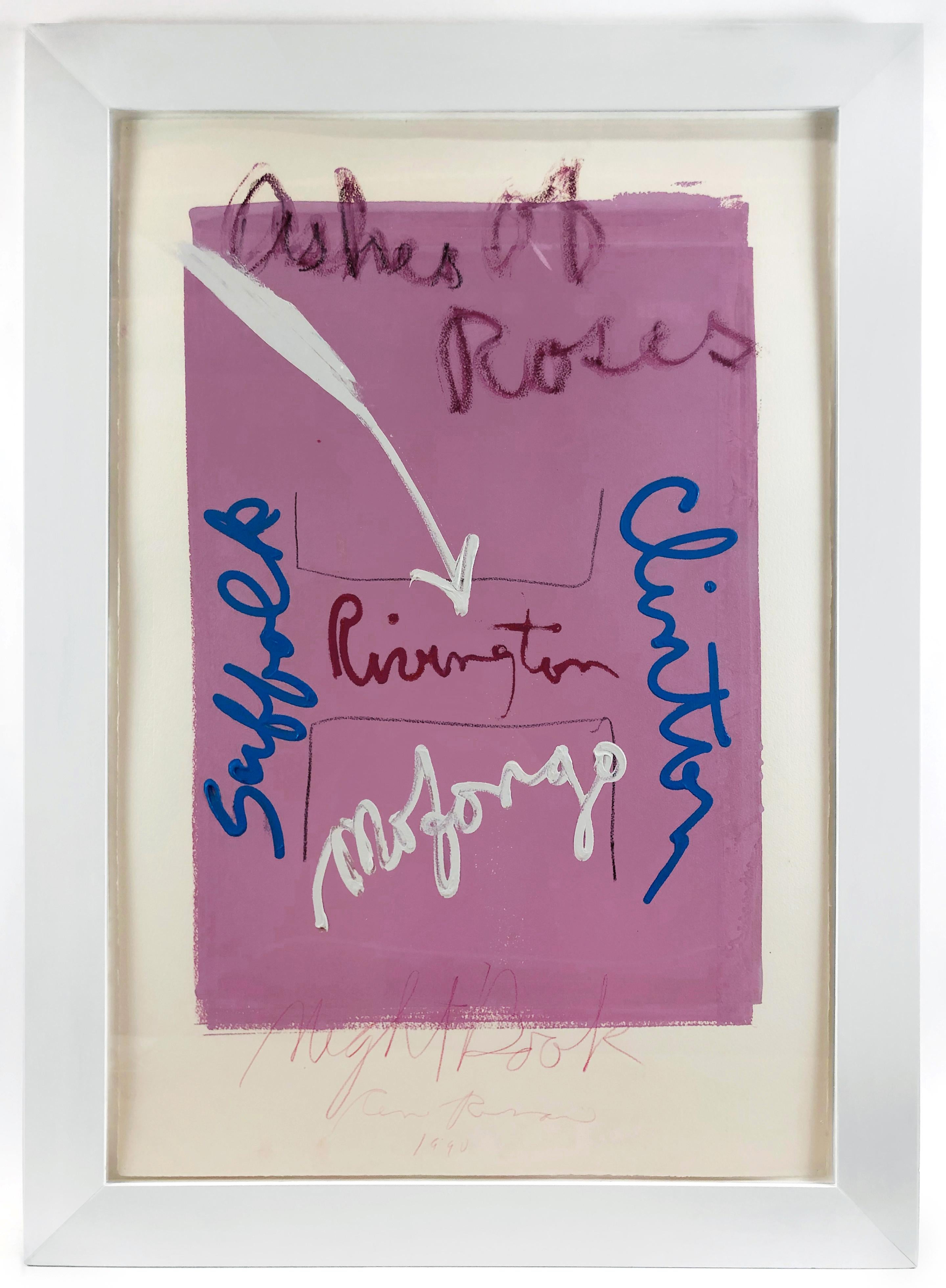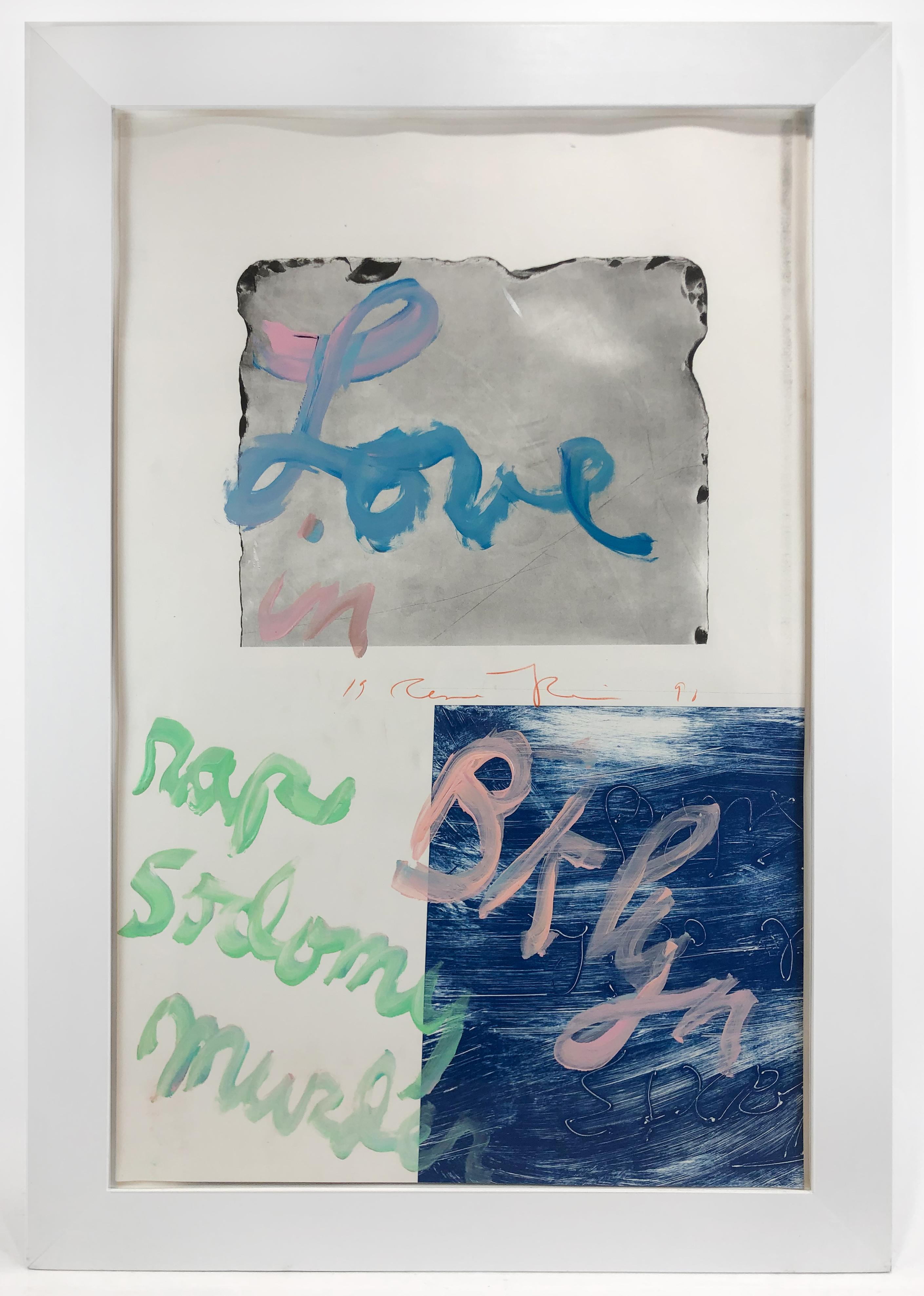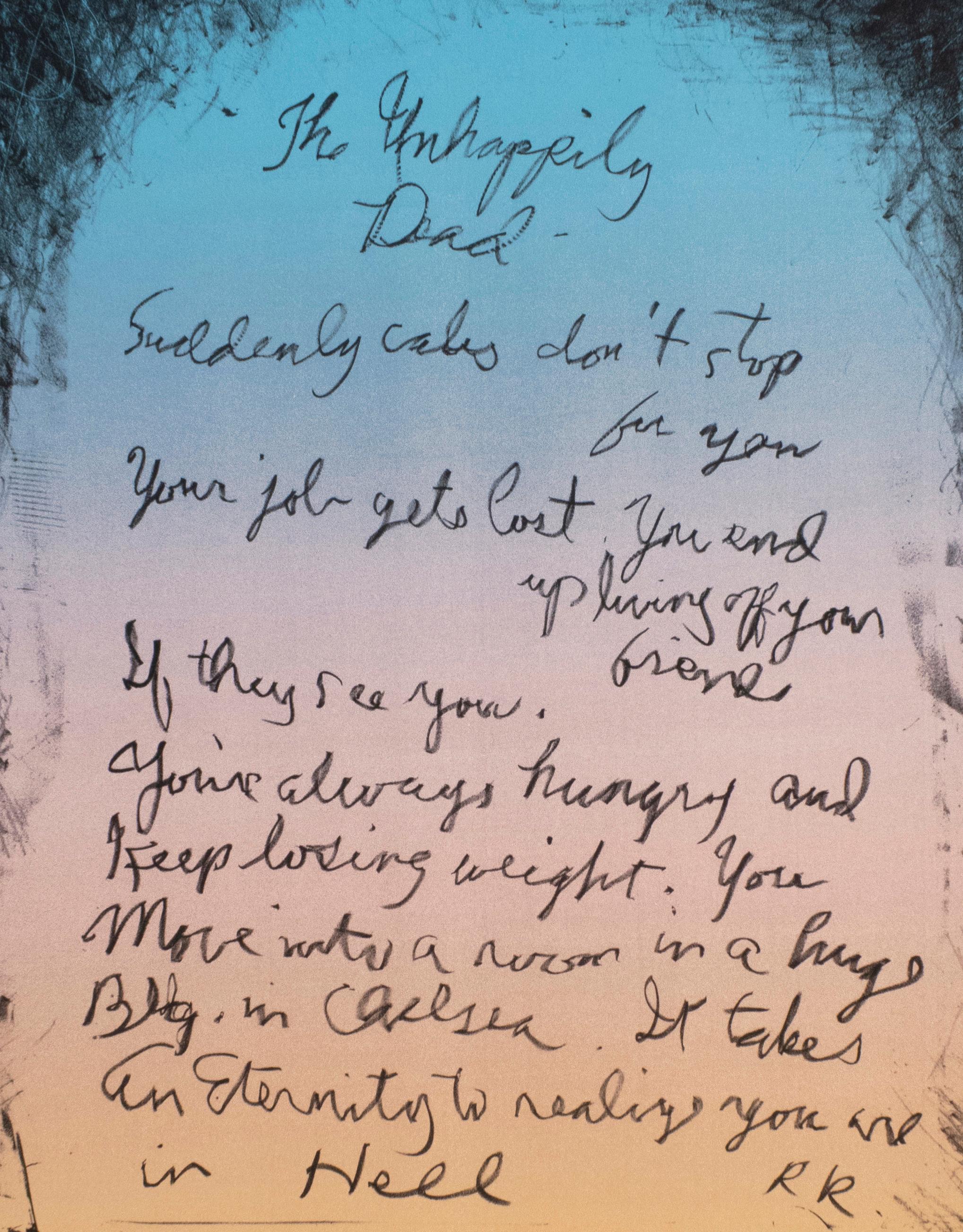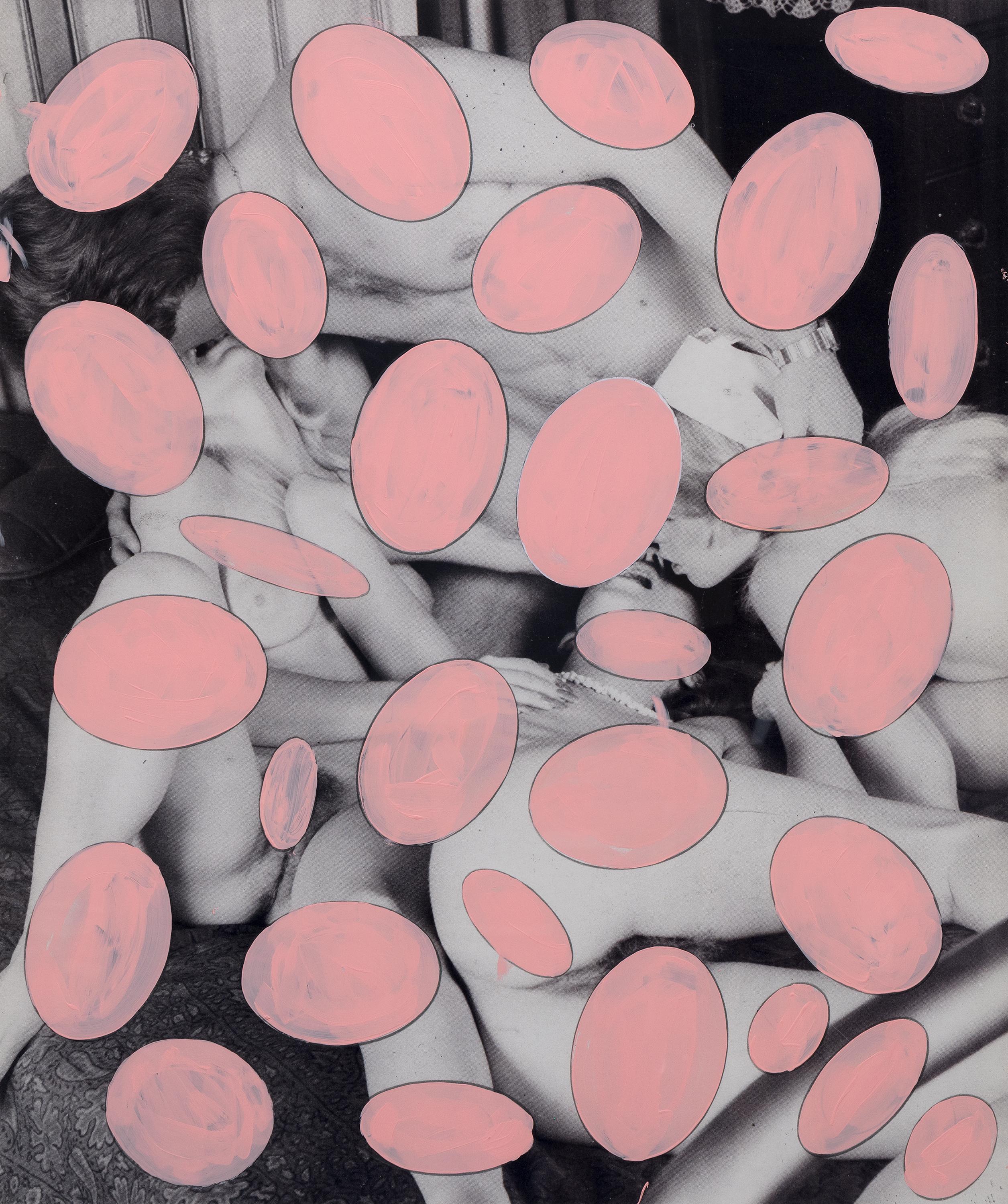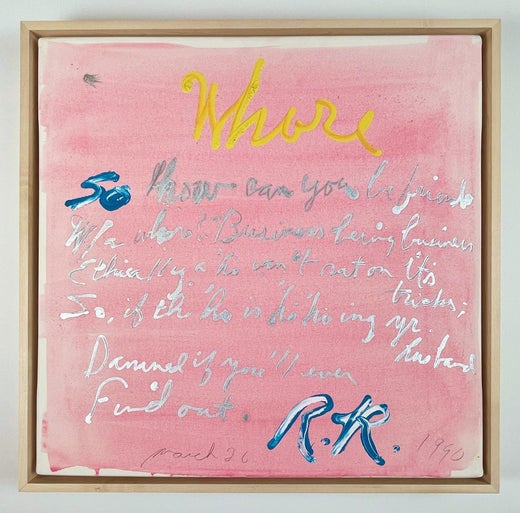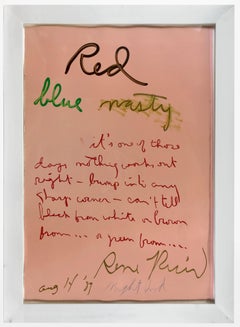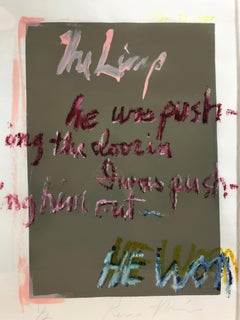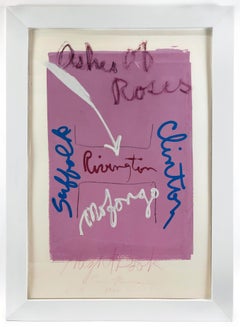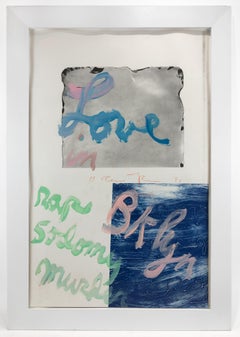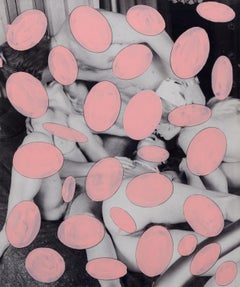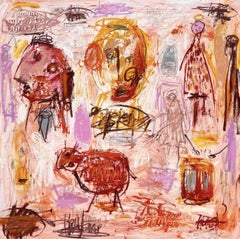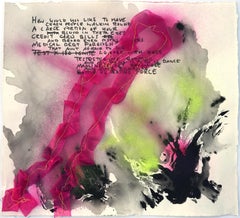Items Similar to Whore by Rene Ricard pink and silver painting with poetry
Want more images or videos?
Request additional images or videos from the seller
1 of 12
Rene RicardWhore by Rene Ricard pink and silver painting with poetry1990
1990
$45,000
£33,858.32
€39,107.08
CA$63,596.75
A$69,012.16
CHF 36,570.37
MX$846,400.59
NOK 452,555.64
SEK 427,641.12
DKK 291,953.84
About the Item
A fluid wash of bubblegum pink fills the surface of this painting. Ricard has written in bright yellow, blue, and vivid silver the following: So how do you be friends w/a whore? Business being business/Ethically, a ho can’t rat on its tricks; so if the ho is hohoing yr husband Damned if you’ll ever find out. March 26.
Whore sharply contrasts the beauty of silver, yellow, and pink with Rene’s pithy, obscene pronouncement. The pink ground is applied in a sheer wash, like Male Cinderella’s background, and the artist’s cursive shimmers in the same silver as One Shoe One You / True Love, Size 3?, and This is not a thanksgiving pumpkin. While Whore shares enticing formal qualities with other works in this group, the text snaps us to cold reality, down into the gutter with a bump. Ricard is happy to visit a fairy tale, but doesn’t stays in the fantasy for long. There’s an intimacy to this work’s smaller scale which compels the viewer to lean in and decode Ricard’s poetry. The artist’s outsized signature is with initials in dark blue, which pop out against that beautiful saturated pink.
Canvas floater frame, in maple with .25 inch moulding.
Whore is part of a group of works dating from 1989-1990 as Rene Ricard prepared for Mal de Fin at the Petersburg Gallery, New York, in 1990, his very first one-man exhibition. Born Albert Napoleon Ricard, he moved to New York in the 1960s at the age of 18. With that relocation, Albert died, and Rene was born. Instantly adopted into Andy Warhol’s glittering orbit, Ricard thrived in the city, with its heady concentration of art, culture, and debauchery. In New York Ricard found the milieu where he would shine.
He acted in underground films, playing Warhol in the artist’s own Andy Warhol Story. He became a renowned poet and writer, published in the Paris Review and Artforum. In typically wry fashion he explained how he became a painter: “I began adding images [to my poetry] because I’ve always liked to draw and paint. And it was hard to find junk-store paintings of the right quality, things that could support some writing, so I just started making the images myself. Unfortunately, people really like that, even though I far prefer just the writing.” Ricard drew on his vast knowledge of literature and art history, weaving these references together with bursts of autobiographical poetry: what the New York Times termed his “seething verbal finesse.”
Ricard, having spent years in the Factory’s milieu, learned from Warhol’s creative strategies. Warhol created images quickly with screen printing, with no regard for perfection. Duplication was the method and the ideology. Ricard, too, worked quickly: urgency was part of his visual language of looped cursive and scribbled colors. He often borrowed a lithographic plate or silkscreen from already-completed works, printing the matrix on canvas or paper to create backgrounds for new works (Size 3’s red printed background may be an example of this). He appropriated thrifted paintings and discarded items such as a pinboard or a piece of insulation, so long as the object in question had a flat surface upon which to work. The two artists were both outsiders to the art world in a sense—Warhol coming from the world of design and Ricard, a bona fide author, but both intuitively understanding how to compel the viewer.
As Warhol anthologized consumerism, Ricard catalogued desire. For example, Size 3 and One Shoe One You feature Ricard’s take on Warhol’s famous shoe drawings which the artist produced in droves. The shoes are labeled with socialites’ and celebrities’ names or by a short musing description. By removing each shoe’s partner, both artists elevated the single shoe into the symbolic realm: for Warhol, each shoe was a character representing an individual, but was also broadly denoting culture. Ricard placed his shoe in the context of Cinderella’s story: a young woman who is orphaned and left to the devices of her evil stepmother. Cinderella is saved after Prince Charming finds her shoe, left behind as she fled the ball at midnight. It’s a story of sadism and suffering, transformation and luck, of late-night parties and hurried exits—very Rene. One Shoe One You reproduces the iconic Disney animated version of Cinderella, with her blue dress, updo, and choker, in olive green and dark grey paint. Around her doubled shadow float a diamond ring and glass slipper. Cinderella stripped of romance is the compact oil paint stunner Whore: with pragmatic musing about a sex worker, pictured in glamorous pink and silver.
Perhaps Ricard could imagine himself as the tragic fairy tale character out past midnight. The artist loved to wear rings and flamboyant fashion. He could be found hobnobbing in the glittering nightlife scene with Andy Warhol and Basquiat, socialites and celebrities, and the next moment stalking the east village in search of a fix or nodding off on endless early morning train rides. Cinderella awaited her savior in the form of Prince Charming, while Rene relied on his own biting wit and charm to keep him afloat, claiming: “I honestly don't need much money. People love to buy me drinks. Hostesses love to feed me. Famous artists lavish me with expensive artworks, and heiresses do the same with jewels that I promptly lose.”
Rene was known for paying bills with paintings and skipping out on debts—had the artist acquired a glass slipper, the precious talisman would certainly have been sold or lost. A stark Nan Goldin portrait pictures Rene, in profile against a spray of cut flowers. He is smoking cocaine through a glass tube, to be discarded like the slipper once broken. He gazes down his aquiline nose, looking elegant even in his debauchery. He is a world away from the baby-faced blond starlet Ricard, photographed at the Factory with Andy Warhol. His swing from day to day between these poles of fame and debasement was as if by cursed enchantment, as Cinderella’s glittering carriage returned to its mundane form after midnight.
But Rene never doubted the power of transformation. In the final paragraph of Ricard’s seminal Basquiat essay “The Radiant Child”, he muses: “We are that radiant child and have spent our lives defending that little baby, constructing an adult around it to protect it from the unlisted signals of forces we have no control over. We are that little baby, the radiant child, and our name, what we are to become, is outside us and we must become “Judy Rifka” or “Jean-Michel” the way I became “Rene Ricard.”
- Creator:Rene Ricard (1946 - 2014, American)
- Creation Year:1990
- Dimensions:Height: 21 in (53.34 cm)Width: 21 in (53.34 cm)Depth: 2 in (5.08 cm)
- Medium:
- Movement & Style:
- Period:
- Condition:In good condition having been in storage in our archive since its creation. Framed in 2024.45000.
- Gallery Location:New York, NY
- Reference Number:1stDibs: LU1211214012862
Rene Ricard
Born Albert Napoleon, artist Rene Ricard moved to New York in the 1960s at the age of 18. With that relocation, Albert died, and Rene was born. Instantly adopted into Andy Warhol’s glittering orbit, Ricard thrived in the city, with its heady concentration of art, culture, and debauchery. He acted in underground films, playing Warhol in the artist’s own Andy Warhol Story, and was lauded by the New York Times in 1981 as “splendid” for his turn in the independent film Underground USA. He was a renowned art writer who launched the careers of artist like Jean-Michel Basquiat and Keith Haring with his poetic essays. In New York, Ricard found the center of his life. In his memoir “Rene Ricard” painter and close friend William Rand calls the artist “the Baudelaire of Avenue C…a brilliant, elusive and glamorous underground figure” adding that Rene’s stomping ground, the East Village, was a “…Halloween show all year round: squatters…hustlers, freaks…” Ricard could be found at any given time of day or night walking these streets, linking up with an endless stream of friends and acquaintances. The city’s underbelly was a bustling hub of culture: one could find artists, critics, gallerists and poets such as Nan Goldin, Julian Schnabel, Francesco Clemente, Bill Stelling, Jean-Michel Basquiat, and Allen Ginsburg mingling in the same gritty milieu. Like the rapidly-changing city, Rene's life was in flux: he moved between living situations and struggled intermittently with addiction, leaving a trail of makeshift canvases and alternately bleak, tender, and acerbic poetry. He had gained prominence and fame as an art critic and poet throughout the 1960s and 70s, but his nascent painting career took shape after gaining the attention of the Petersburg Press Gallery. They were to present his first exhibition in New York in 1990. The upcoming show proved to be a motivating force, harnessing Ricard's raw talent by providing him with studio assistants and a place to work at Petersburg’s studio on Lafayette Street. The show was to be entitled “Mal de Fin”. French for "Bad End", Mal de Fin may be a play on "fin de siècle": the end of an era and the beginning of another, and "mal du siècle": sickness of the century, a phrase attributed to the 18th/19th century French writer François-René de Chateaubriand. Chateaubriand’s notion of turn-of-the-century ennui no doubt resonated with the famously moody artist, and Ricard’s name change may have been inspired by Chateaubriand’s first name François-René. Mal de Fin’s body of work reflected not only his wild lifestyle, but the artist’s interest in spirituality, literature, and art itself.
About the Seller
5.0
Recognized Seller
These prestigious sellers are industry leaders and represent the highest echelon for item quality and design.
Platinum Seller
Premium sellers with a 4.7+ rating and 24-hour response times
Established in 1968
1stDibs seller since 2019
326 sales on 1stDibs
Typical response time: <1 hour
- ShippingRetrieving quote...Shipping from: New York, NY
- Return Policy
Authenticity Guarantee
In the unlikely event there’s an issue with an item’s authenticity, contact us within 1 year for a full refund. DetailsMoney-Back Guarantee
If your item is not as described, is damaged in transit, or does not arrive, contact us within 7 days for a full refund. Details24-Hour Cancellation
You have a 24-hour grace period in which to reconsider your purchase, with no questions asked.Vetted Professional Sellers
Our world-class sellers must adhere to strict standards for service and quality, maintaining the integrity of our listings.Price-Match Guarantee
If you find that a seller listed the same item for a lower price elsewhere, we’ll match it.Trusted Global Delivery
Our best-in-class carrier network provides specialized shipping options worldwide, including custom delivery.More From This Seller
View AllRene Ricard Red Blue Nasty, 1989 poetry painting Keith Haring reference
By Rene Ricard
Located in New York, NY
Frustration is center stage, written in cursive: "It's one of those days nothing works out right -- bump into any sharp corner – can’t tell flesh from white or brown from…or green fr...
Category
1980s Contemporary Abstract Paintings
Materials
Oil, Acrylic, Screen
The Limp by Rene Ricard abstract poetry painting
By Rene Ricard
Located in New York, NY
The Limp conjures the image of Rene consumed with energy and righteousness, then resignation: "He was pushing the door in, I was pushing him out / He won". The words are scrawled in ...
Category
1980s Abstract Abstract Paintings
Materials
Oil, Acrylic, Screen
Ashes of Roses by Rene Ricard 1989 New York Lower East Side poetry LES
By Rene Ricard
Located in New York, NY
Ashes of Roses is Rene Ricard's mauve-colored map of Rivington Street between Suffolk and Clinton Street, with a white arrow pointing to the word mofongo, indicating a Puerto Rican r...
Category
1980s Abstract Paintings
Materials
Oil, Acrylic, Screen
Love in Brooklyn by Rene Ricard poetry painting
By Rene Ricard
Located in New York, NY
Love in Brooklyn, painted in baby blue, light pink, and pale green, depicts a stark image of Brooklyn, which had not yet seen the development spreading across Manhattan: “Love in Bro...
Category
1990s Abstract Paintings
Materials
Oil, Acrylic, Screen
The Unhappily Dead: Rene Ricard poetry of 1980s Chelse New York life rainbow
By Rene Ricard
Located in New York, NY
Touched by the influence of Andy Warhol, champion of a young Jean-Michel Basquiat, Rene Ricard served as enfant terrible of the 1980s New York art scene. In this rainbow print, Ricar...
Category
1980s Contemporary Abstract Prints
Materials
Lithograph
Monet Portrait of Jeanne Duval: Ricard drawing vintage typewriter love poetry
By Rene Ricard
Located in New York, NY
Touched by the influence of Andy Warhol, champion of a young Jean-Michel Basquiat, Rene Ricard served as enfant terrible of the 1980s New York art scene. Here, Ricard traverses visual art, text, and the pleasure of sculptural trompe-l’œil with this printed drawing of melancholy hand-written and typed love poetry, composed with natural earthen shades of antique white and brown.
Monet Portrait of Jeanne Duval...
Category
1980s Contemporary Abstract Prints
Materials
Lithograph
You May Also Like
Untitled (Censor Painting Pink)
By Richard Prince
Located in Palm Desert, CA
"Untitled (Censor Painting Pink)" is a nude figurative acrylic on inkjet board painting by Richard Prince in 2009. The artwork is 35 1/2 x 30 inches and 37 1/2 x 32 x 1 1/2 inches wi...
Category
21st Century and Contemporary Contemporary Nude Paintings
Materials
Inkjet, Acrylic
Pink-ish, Painting, Oil on Canvas
By Laurent Proneur
Located in Yardley, PA
Pink, a hue so soft and bright, In gardens blooming, a lovely sight. Like cotton candy in the fair, It whispers sweetness everywhere. :: Painting :: Abstract Expressionism :: This...
Category
2010s Abstract Expressionist Paintings
Materials
Oil
How Would You Like To Have- Mixed Media Text Based Abstract Work on Paper
By Vivian Liddell
Located in Gilroy, CA
"How Would You Like To Have," is a text based mixed media contemporary abstraction by artist Vivian Liddell. This piece is very gestural with the application of the mediums cohesivel...
Category
2010s Contemporary Abstract Paintings
Materials
Spray Paint, Monotype, Thread, Ink
Justin McCarthy Nude Painting, Outsider Artist
Located in Lake Worth Beach, FL
Artist/Designer; Manufacturer: Justin McCarthy (American, 1891-1977)
Marking(s); notes: no marking(s) apparent
Materials: board/panel
Dimensions (H, W, D): 24"h, 18"w
Additional Info...
Category
20th Century Outsider Art Figurative Paintings
Materials
Paint, Board
I am the Whore and the Holy Woman
By Anastasia Pelias
Located in New Orleans, LA
Anastasia Pelias was born in New Orleans, LA to a Greek immigrant mother and a first generation Greek-American father. She received her BFA from the Newcomb College of Tulane Univers...
Category
21st Century and Contemporary Contemporary Abstract Paintings
Materials
Canvas, Oil
It's For People Like You That Keep It Turned On (Peach)
By Bernie Taupin
Located in Toronto, ON
34" x 28" Framed
Original - Mixed Media on Paper
Hand Signed by Bernie Taupin
Category
21st Century and Contemporary Abstract Paintings
Materials
Paper, Mixed Media
